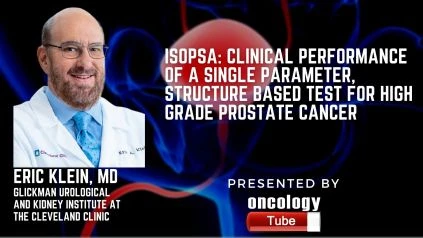Eric Klein, MD from the Glickman Urological and Kidney Institute at the Cleveland Clinic speaks about the AUA 2021 Abstract – MP60-03 ISOPSA: CLINICAL PERFORMANCE OF A SINGLE PARAMETER, STRUCTURE BASED TEST FOR HIGH GRADE PROSTATE CANCER IN A LARGE, MULTICENTER, PROSPECTIVE VALIDATION TRIAL.
Link to the Abstract:
https://www.auajournals.org/doi/abs/10.1097/JU.0000000000002095.03
A Summary –
OBJECTIVE AND INTRODUCTION:
In a large-scale prospective validation experiment, we offer cumulative results detailing the clinical efficacy of IsoPSA, a blood-based, structure-focused test for high-grade prostate cancer.
Methodologies:
Blood samples were collected from several clinical sites within 30 days prior to prostate biopsy from patients with serum PSA between 4 and 100 ng/ml in this validation experiment (N = 1093). As a gold standard, IsoPSA was compared to TRUS and/or MRI Fusion biopsy data. In the study group, 35.3 percent of men had high-grade prostate cancer (PCa). ROC analysis was used to compare the test parameter (IsoPSA Index) to total PSA and percent free PSA.
Outcomes:
At the specified threshold value (6.0), ROC analysis utilizing the test parameter, IsoPSA Index, yielded AUC=0.790, sensitivity=90.4 percent, specificity=47.1 percent, NPV=90.0 percent, and PPV=48.3 percent to identify patients at low risk for high-grade PCa. IsoPSA outperformed total PSA, percent free PSA, and percent free PSA (total PSA 4-10 ng/mL) in terms of AUC, specificity, NPV, and PPV. In both biopsy naive and prior negative biopsy populations, the AUC, sensitivity, and specificity of IsoPSA were constant and lasting. The usage of alpha 1-blockers (AUC=0.795) and 5-ARI (AUC=0.789) medicines had no effect on the diagnostic accuracy of IsoPSA. In the validation cohort, an estimated 47.1 percent of biopsies targeting high-grade illness may have been avoided using IsoPSA.
Observations:
In estimating the risk of high-grade PCa, isoPSA outperforms total PSA and percent free PSA in terms of diagnostic accuracy. In low-risk patients, the adoption of IsoPSA in the clinic would have resulted in a large reduction in unnecessary biopsies. IsoPSA has also been shown to be useful in people with symptomatic BPH who are on normal treatment regimens.
Funding Sources:
Cleveland Diagnostics, Inc. is a medical diagnostics company based in Cleveland, Ohio

